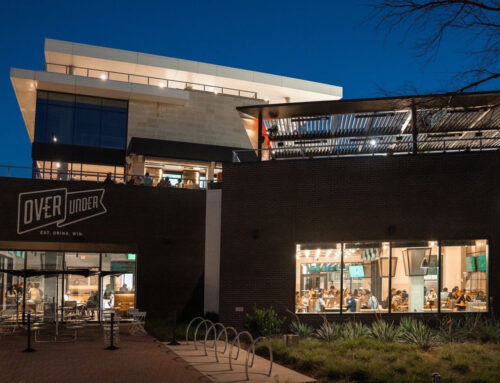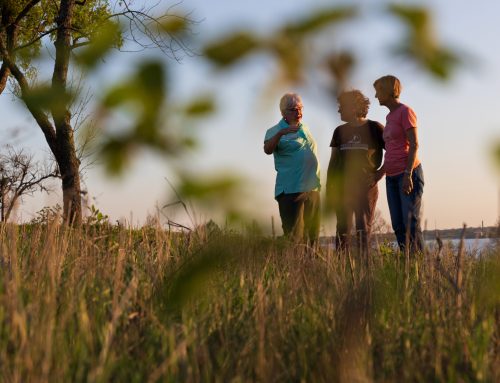When they decided to build their dream home, North Dallasites Bill and Elizabeth Wallace chose a 3,500-square-foot, Mediterranean-style design for their lot in our neighborhood on Goodwin, west of Greenville Avenue.
“We knew what we wanted to have, so rather than inherit someone else’s idea of what should be in a house, we decided to build it ourselves,” says Wallace, whose builder is Belmont Homes.
One of the reasons the Wallaces chose their lot was the diversity of homes in the surrounding neighborhood, Wallace says — he and Elizabeth wanted their home, architecturally, to “blend into the neighborhood.”
“We tried to be very respectful of the neighborhood in terms of setbacks … in terms of not building a 6,000-square-foot home that just jumps out at you when you drive down the street.”
But, of course, as is often the case in our neighborhood, not everyone was happy with the Wallaces’ attempts at architectural assimilation. The reaction from neighbors, he says, was “mixed and frankly a little surprising.”
“We’ve met probably a half-dozen of our neighbors in the general area, and I’d say the majority have been very nice and very welcoming,” Wallace continues. “We’ve had a few that have been fairly hostile, particularly in terms of — well, I’d say all-in-all we’ve had construction delayed probably four to six weeks based on calls to the city.”
While city factions debate the necessity and parameters of Neighborhood Stabilization Overlay Districts, the real battles go on in neighborhoods such as ours, where many longtime residents view teardowns as an epidemic.
Reaction to new-home construction has a variety of expressions — from outright hostility and repeated attempts to halt progress, to secretly seething about our new neighbor’s lack of respect and taste while we smile and wave at them as they pull in and out of their driveways.
There are, of course, those who view new residential development as the inevitable outcome in a neighborhood experiencing a surge in popularity.
But ask strangers on the street their opinion of teardowns, and you’re more likely to hear a diatribe than see a simple shrug of the shoulders.
But what about the people who build and live in these homes? Have their experiences been negative? Are they, as one of them put it, really the “green ogres” living among us that many longtime residents seem to think they are?
More importantly, is it possible we’re doing even more damage to the character of our neighborhoods by letting this issue become, in some cases, highly personal?
Builder Elizabeth Newman is well aware of the opinion some residents have of her.
“I’ve had people spit on me and send me hate mail — all kinds of things like that,” Newman says matter-of-factly. “Do I think people are real happy with me? No.”
A few months ago, Newman — who heads Elizabeth Newman Custom Homes — sat on a panel for a Lakewood Neighborhood Association meeting at the Lakewood Country Club. She was, she says, the only builder on the panel, but others were in attendance.
“I was ripped apart for over an hour. I took a beating like you wouldn’t believe, and my fellow builders sat in the background and never said a word and let me take the heat,” she says.
Newman says she wasn’t surprised by the treatment — she’s a highly visible target, after all. But, perhaps surprisingly, experiences such as those of Newman and the Wallaces seem to be the exceptions rather than the rule.
Leisa Pulliam moved into the neighborhood in July 2004. She lives on Goliad with her husband and two daughters in a new-construction home.
“When we moved in, within less than 24 hours, my kids had met probably 80 percent of the neighbors,” Pulliam says. And until earlier this year, when an Advocate article articulated some longtime residents’ frustration with teardowns and so-called “McMansions,” Pulliam says she had little inkling that a problem even existed.
But she’s quick to add: “I haven’t had those issues with my neighbors.”
Howard Roth moved into a home he had built on Palo Pinto earlier this year. He hasn’t clashed with his neighbors, he says, though he adds he hasn’t had a chance to meet many of them. He hopes, though, that if his neighbors have opinions of him, they’re based on something other than where he lives.
“I don’t want to be judged because of the house I live in, and I’m not judging people because of the house they live in,” he says. “I’m not a visitor — I live here. I think they need to get to know me.”
Pulliam agrees, adding that she thinks people who live in teardowns are often misjudged. She and Roth both say they chose to live in this neighborhood for many of the same reasons longtime residents continue to live here.
“I want to be able to walk to get my haircut, walk to get my dog taken care of. We walk to eat. We walk to the park,” she says. “I don’t want a WalMart Supercenter here; I don’t want cookie-cutter restaurants. But people are assuming because of my age and what they think my profession is that that’s what I want. I think that’s a problem.”
Plus, she says, if those who dislike new construction want to see things resolved, “they’re not going to make a difference when they’re calling us selfish and don’t even want to be in same room with us.”
For his part, Wallace says the treatment he has received from one neighbor in particular “borders on harassment.”
“They know how to reach us, they’ve got our numbers, they certainly have [builder] Belmont’s numbers,” he says. “But instead of saying, ‘Hey, I’m concerned. Help me understand what’s going on,’ they say, ‘Let’s call the city, and try to get the project scrapped.’ It’s just not a way to build a neighborly relationship.”
Neighborhood resident and Realtor Michael Campbell, who also owns Spirit River Homes, wants residents to understand that new construction is likely here to stay.
“I think what we’re seeing now is the inevitable consequence of that first effort at revitalizing older neighborhoods,” says Campbell, whose company, he says, builds “high-end homes that are in keeping with the feel of the neighborhood.”
“We should embrace redevelopment, because A) it’s here to stay, and B) we should be happy people want to move into and revitalize older neighborhoods,” he says.
“I mean, my God, they were stagnant for half a century, and thankfully, we have development and growth and vitality coming back into these neighborhoods. We shouldn’t do everything we can to stop it.”
Still, Campbell says he understands the concern of longtime residents who want to see development done right. But “finger-pointing and name-calling” won’t do anyone any good, he says.
Newman agrees.
“Yes, it bothers me a lot,” she says of reaction to the homes she builds. But she agrees that market demand will continue, so she doesn’t have any plans to change what she’s doing.
“I’m not going to lose sleep over it,” she says simply. “Because if I don’t build it, somebody else will.”
Campbell says the key is more honest discussion.
“We need to stop vilifying not only the builders, but people who buy their product. We need more open communication — maybe something like workshops. We need homeowner’s associations reaching out to builders,” he says.
“The thing is to just do it with an eye to what has gone before, and be sympathetic to it. We just find a way to manage it going forward — we certainly don’t throw the baby out with the bathwater.”
Wallace, who is building the house on Goodwin, says he thinks the majority of people see those who take the issue to a nastier level as more of a “lunatic fringe that wants to keep things the way they were in 1930.”
“But that’s one of wonders of being in a free country,” he says with some degree of exasperation. “You are kind of free to do what you want within the bounds of code and propriety and all that.
“It’s unfortunate — Elizabeth and I consider ourselves to be pretty friendly folks and want to become involved in the neighborhood association and have gone out of our way to meet as many of our neighbors as we can. And we want to be viewed in a positive light. I don’t think the vast majority are going to find us evil.”
Pulliam, who feels lucky to have tolerant neighbors, has a plea for all neighborhood residents:
“You can’t create a perfect world. The best you can hope for is a balanced world,” she says. “It wasn’t perfect before ‘we’ — so called — came along, and it won’t be perfect after we get here. But you’re going to have to value every person for what they’re worth and understand that everyone has something to contribute to neighborhood.
“It’s just a balancing act.”





